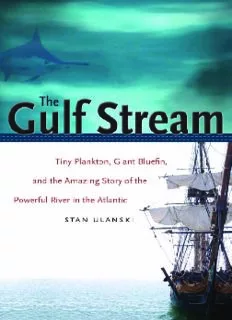
The Gulf Stream: Tiny Plankton, Giant Bluefin, and the Amazing Story of the Powerful River in the Atlantic PDF
Preview The Gulf Stream: Tiny Plankton, Giant Bluefin, and the Amazing Story of the Powerful River in the Atlantic
The Gulf STReam T he Gul f S Tre a m T he Gul f S Tre a m Tiny Plankton, Giant Bluefin, and the Amazing Story of the Powerful River in the Atlantic Stan Ulanski The University of North Carolina Press | Chapel Hill © 2008 The University of North Carolina Press All rights reserved Designed by April Leidig-Higgins Set in Garamond PremierPro by Copperline Book Services Manufactured in the United States of America The paper in this book meets the guidelines for permanence and durability of the Committee on Production Guidelines for Book Longevity of the Council on Library Resources. The University of North Carolina Press has been a member of the Green Press Initiative since 2003. Library of Congress Cataloging-in-Publication Data Ulanski, Stan L., 1946 – The Gulf Stream: tiny plankton, giant bluefin, and the amazing story of the powerful river in the Atlantic / Stan Ulanski. p. cm. Includes bibliographical references and index. ISBN 978-0-8078-3217-2 (cloth: alk. paper) 1. Gulf Stream. I. Title. gc269.u43 2008 551.46'2131 — dc22 2008004746 A Caravan book. For more information, visit www.caravanbooks.org. 12 11 10 09 08 5 4 3 2 1 University of North Carolina Press books may be purchased at a discount for educational, business, or sales promotional use. For information, please visit www.uncpress.unc.edu or write to UNC Press, attention: Sales Department, 116 South Boundary Street, Chapel Hill, NC 27514-3808. ConTenTS Preface ix Acknowledgments xv PaRT 1 CominG full CiRCle: flow in The aTlanTiC 1 Swirls and Conveyors 3 2 Anatomy of the Gulf Stream 23 3 Flowing Down the Hill: The History of Ocean Circulation 39 PaRT 2 life in The Gulf STReam 4 Floaters and Drifters 63 5 Bluefin Tuna: The Great Migration 87 6 Fishing the Blue Waters 107 PaRT 3 SailinG The aTlanTiC 7 Exploration and Discovery 131 8 Colonization of America 155 Epilogue 193 Bibliography 197 Index 207 This page intentionally left blank illuSTRaTionS 5 Simplified view of an ocean gyre 8 Ocean currents in the North Atlantic 10 Currents in the Caribbean and the Gulf of Mexico 12 Opening of the Atlantic Ocean, 200 million years ago to the present 16 Gulf Stream meanders and rings off the mid-Atlantic coast 18 Carta Marina by Olaus Magnus 21 Conveyor-belt circulation, surface component and deep component 31 Infrared image of the Gulf Stream departing the North Carolina coast 32 Warm-core rings, north of the Gulf Stream 33 Weakening of the Gulf Stream at higher latitudes 34 Winslow Homer’s The Gulf Stream 55 Ekman spiral and transport 58 Hill of water and geostrophic flow 59 Western intensification of gyre 65 Diatoms 74 Portuguese man-of-war 76 By-the-wind sailor 78 Sargassum weed 83 Pipefish 89 Bluefin tuna viii Illustrations 114 Dolphinfish 117 Wahoo 120 Gulf Stream sailfish 133 Caravel with lateen sails 141 Voyage routes of Columbus, Cabot, and Alaminos 145 Bermuda high-pressure center 156 Square-rigged ship 178 Molasses-rum-slave triangle PRefaCe I winced slightly when my fishing companion, Matt, queried me about the effects of the Gulf Stream on the game fish that we were seeking on a charter out of a North Carolina marina. As a professor, I have come to expect, though reluctantly accept, almost a complete unawareness of the Gulf Stream from students in my introductory oceanography class. Even Matt, an experienced angler, had woefully little knowledge about the mighty, warm, and deep current, flowing like a river just off the At- lantic coast. Matt listened eagerly to my explanation of how water tem- perature gradients of the Gulf Stream concentrate game fish prey, and how this powerful current affects all life forms, from the tiniest bioluminescent plankton to the largest bluefin tuna. In retrospect, there was a time when my own knowledge of the Gulf Stream was at best scanty, but that started to change more than three de- cades ago, when I took my first research cruise. Like the mariners of a bygone period, I sailed into the realm of the Gulf Stream, experiencing firsthand this relentless flow of the Atlantic — where cobalt-blue water rushed past our ship, and where tuna and marlin roamed in search of an easy meal. But my early sea adventure would not start off smoothly; I was seasick most of the way out. I soon learned that queasiness was no excuse for avoid- ing the routine task of taking measurements at sea. Called on deck by the senior scientist one evening, I was startled to see the bow of the ship aglow with a pale light. Little did I know at that time that large accumulations of microscopic plants, called dinoflagellates, in the Gulf Stream produce “phosphorescent seas,” where the waters glow an electric blue. But my enjoy- ment of the light show was short-lived; the ship growled to a stop. A heav- ily rolling ship, a heaving stomach, and swinging instruments don’t make for a pleasant sea experience. But persevering, I soon came to realize that my measurements yielded one of the defining characteristics of the Gulf Stream: its relatively high temperature, above 80°F (27°C). As I retired to
Description: